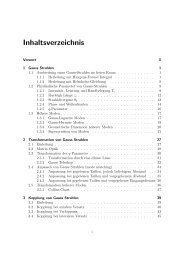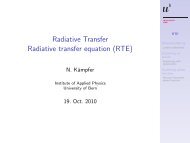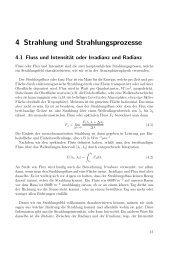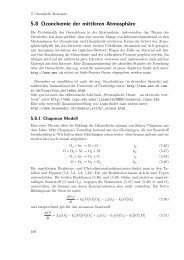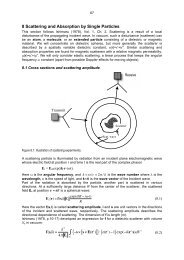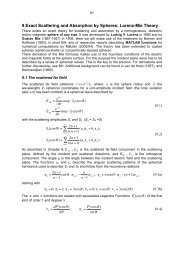Radiative Transfer Radiative transfer equation (RTE) - IAP ...
Radiative Transfer Radiative transfer equation (RTE) - IAP ...
Radiative Transfer Radiative transfer equation (RTE) - IAP ...
You also want an ePaper? Increase the reach of your titles
YUMPU automatically turns print PDFs into web optimized ePapers that Google loves.
<strong>Radiative</strong> <strong>Transfer</strong><br />
<strong>Radiative</strong> <strong>transfer</strong> <strong>equation</strong> (<strong>RTE</strong>)<br />
without scattering<br />
N. Kämpfer<br />
<strong>RTE</strong><br />
Beer’s law<br />
Abs. cross section<br />
Opacity &<br />
Transmission<br />
Mean free path<br />
Scattering<br />
Schwarzschild eq.<br />
Institute of Applied Physics<br />
University of Bern<br />
12. Oct. 2010
Outline<br />
Beer’s law in nonhomogeneous medium<br />
Absorption cross section<br />
Opacity & Transmission<br />
Photon mean free path<br />
<strong>RTE</strong><br />
Beer’s law<br />
Abs. cross section<br />
Opacity &<br />
Transmission<br />
Mean free path<br />
Scattering<br />
Schwarzschild eq.<br />
A first look at scattering<br />
Schwarzschild <strong>equation</strong>
Absorption by a non homogeneous medium<br />
Example for absorption of solar radiation in the atmosphere<br />
Radiation is passing through<br />
layer dz under zenith-angle θ<br />
Radiation is attenuated by<br />
amount dI along path ds<br />
ds = sec θdz = 1<br />
cos θ dz = 1 µ dz<br />
1/µ is called air mass factor<br />
Law of Beer-Lambert<br />
to consider the<br />
ase of scattering by a spherical particle of radius r,<br />
rr rvhich the scattering, absorption, or extinction<br />
fficiency K1 in (4.16) can be prescribed on the<br />
(- d(<br />
ig. 4.10 Extinction of incident parallel beam solar radiacn<br />
as it passes through an infinitesimally thin atmospheric<br />
Lver concaining absorbing gases and/or aerosols.<br />
dI (λ) = −k a (λ)I (λ)ds<br />
particle. Figu<br />
eters for va<br />
phere and ra<br />
For the scatt<br />
the spectrum<br />
air molecule<br />
)>1 for rain<br />
Particles w<br />
scattering rad<br />
scattering reg<br />
<strong>RTE</strong><br />
Beer’s law<br />
Abs. cross section<br />
Opacity &<br />
Transmission<br />
Mean free path<br />
efficiency is o<br />
Scattering<br />
and the scat<br />
forward and b<br />
Fig.4.12a. For<br />
ble to or grea<br />
directed mainly<br />
cated in subse<br />
Figure 4.13 s<br />
ter for particle<br />
of m;. Conside<br />
Schwarzschild eq.<br />
◮ k a (λ) is called absorption coefficient. Dimension is m −1<br />
◮ k a (λ) is proportional to number density: k a (λ) = σ a (λ)n<br />
◮ σ a (λ) is called absorption cross section<br />
◮ k a (λ) = ρk m (λ): k m is mass abs. coefficient, [m 2 /kg]
qru €r0r) sos?a rueqdso<br />
E6<br />
r.llouoloAeM<br />
Lur! | uuru L' r-urj<br />
0l r.r.rrj<br />
L urrl L'<br />
ue6Äx-g<br />
uoqrec<br />
joleM<br />
"" 01<br />
tt-0 L<br />
ot-0 L<br />
ot-0 L<br />
n-0 L<br />
""-01 er-0l'<br />
or-0 L<br />
or-0 L<br />
n-0 L<br />
"r-01 *-0L<br />
or-0 L<br />
ot-0 L<br />
n-0 L<br />
""-ol *-0 |.<br />
or-0lor-0<br />
L<br />
n-o L<br />
""-01 rr-0 L<br />
or-0 L<br />
or-o L<br />
n-0 L<br />
slnp1l aLlJ :saryralory {q uo4dtosqy g'a<br />
r<br />
p<br />
r<br />
v<br />
w<br />
a<br />
o<br />
?<br />
N<br />
=<br />
N<br />
v<br />
a<br />
g<br />
o<br />
p<br />
N<br />
N<br />
N<br />
F<br />
- N<br />
puu 'oroz,{llertues<br />
-eJJO UOISSIIUStrEi]i<br />
UoISSIIUE'9'0 sp3:rl<br />
-er srql urqlrm seiu:<br />
puB eplxolp uoqJr-1 '<br />
uoIleIpE Jelos q-.:r<br />
,{lr.trssrrusuert<br />
eql sr 1r esneraq<br />
u:<br />
:e,to Surq.tosqe i1;.<br />
go uorldecxa Jqt L'<br />
8uue11ecs puc uorr;<br />
-oru1u,{q SuFarr::.<br />
-Jrp po{reru aqr i:,:<br />
eqr 'l(zz'o'b3<br />
:;.<br />
-re,t u 3uole potri!:;:<br />
Jo^o urns eql 8ui:q<br />
eltnb eru selnJelrrru<br />
-3es ssorc uoudrosü<br />
sI qlSuole^€,r'suLr<br />
peJB4ur eql olur (-..<br />
e^IlurpeJ autl-.iq- a ii<br />
-runu sJr oJ ]u0rJrlf:,<br />
-drosqe er{J'salnr:'<br />
xIS rolo () t6l pu<br />
suorcqd Jb LltDae )q-L<br />
Absorption cross sections of some molecules<br />
from the visible to the microwave<br />
<strong>RTE</strong><br />
-3es ssoJc ,^Aoq\\o-<br />
' sJeq{unue^e,r :.i -1o<br />
ruoJJ luepr^e sr stlns<br />
elelclp SeUIf OSeQItr<br />
'pernldec eJB slrpte<br />
''3'e) sp,trelur IIErx<br />
- N<br />
Beer’s law<br />
Abs. cross section<br />
Opacity &<br />
Transmission<br />
Mean free path<br />
Scattering<br />
Uouoao<br />
Schwarzschild eq.<br />
-ncelou qJee Jo-l sr<br />
erlceds eseql .\\oq ;<br />
""-01 *-0L<br />
or-0 L<br />
or-0 L<br />
g-o I<br />
ez-j1<br />
rt-0 L<br />
or-0 L<br />
ot-0 L<br />
n-o L<br />
a"-01<br />
*-0L<br />
ot-0 L<br />
or-0 L<br />
n-0 L<br />
um €'0 o] run ! 1-ṟ<br />
- N<br />
aqt -<br />
ull{]la 'eprxorp u.}r<br />
8'0 ruo4 pue 'uai",:<br />
ur f' uruj 0|.<br />
Surqceorddu 'sasc:-<br />
uollelpeJ S,t{llel rrl<br />
copied from Bohren, Fundamnetals of atmospheric radiation
Opacity and transmittance<br />
Atmosphere consists of many different species<br />
→ every constitutent contributes in its own way<br />
k a = ∑ k a,i = ∑ n i σ a,i = ∑ ρ i k m,i<br />
i<br />
i<br />
i<br />
Absorption along a path element ds is given by Beer Lambert<br />
dI (λ) = −k a (λ)I (λ)ds<br />
<strong>RTE</strong><br />
Beer’s law<br />
Abs. cross section<br />
Opacity &<br />
Transmission<br />
Mean free path<br />
Scattering<br />
Schwarzschild eq.<br />
which after integration over the whole atmosphere yields<br />
I (λ) = I 0 (λ)e −τa(λ,s)<br />
Opacity τ: τ a (λ, s) = ∫ s σ a(λ)n(s)ds = ∫ s k a(λ, s)ds<br />
Penetration depth: δ = 1/k a<br />
Transmittance: t(λ, s) = e −τa(λ,s) ⇒ t ≈ 1 − τ a for τ a ≪ 1<br />
Absorptivity: a(λ, s) = 1 − t(λ, s) ⇒ a ≈ τ a for τ a ≪ 1<br />
CAVE! absorptivity is not the same as absorption coefficient!
Transmission of Earth atmosphere<br />
Contribution of different species in the UV to infrared<br />
Transmittance<br />
Transmittance<br />
Transmittance<br />
Transmittance<br />
1<br />
0<br />
1<br />
0<br />
1<br />
0<br />
1<br />
ZENITH ATMOSPHERIC TRANSMITTANCE<br />
UV VIS Near IR Thermal IR<br />
CO 2<br />
0<br />
0<br />
0.3 0.4 0.5 0.6 0.8 1 1.2 1.5 2 2.5 3 4 5 6 7 8 910 12 15 20 25 30 40 50<br />
Wavelength [µm]<br />
copied from Petty, Atmospheric radiation<br />
CO<br />
N 2<br />
O<br />
CH 4<br />
O 2<br />
0<br />
O 3<br />
H 2<br />
O<br />
Total<br />
1<br />
0<br />
1<br />
1<br />
1<br />
0<br />
Transmittance<br />
Transmittance<br />
Transmittance<br />
Transmittance<br />
<strong>RTE</strong><br />
Beer’s law<br />
Abs. cross section<br />
Opacity &<br />
Transmission<br />
Mean free path<br />
Scattering<br />
Schwarzschild eq.
Transmission of Earth atmosphere<br />
Microwave regime<br />
1<br />
Zenith Microwave Transmittance<br />
<strong>RTE</strong><br />
Transmittance<br />
0.9<br />
0.8<br />
0.7<br />
0.6<br />
0.5<br />
0.4<br />
Oxygen<br />
Water Vapor (21.3 kg m -2 )<br />
Cloud Liquid Water (0.2 kg m -2 )<br />
Total<br />
Beer’s law<br />
Abs. cross section<br />
Opacity &<br />
Transmission<br />
Mean free path<br />
Scattering<br />
Schwarzschild eq.<br />
0.3<br />
0.2<br />
0.1<br />
0<br />
0 50 100 150 200 250 300<br />
Frequency [GHz]<br />
copied from Petty, Atmospheric radiation
Transmission of Earth atmosphere<br />
Microwave regime<br />
1<br />
Zenith Microwave Transmittance<br />
<strong>RTE</strong><br />
Transmittance<br />
0.9<br />
0.8<br />
0.7<br />
0.6<br />
0.5<br />
0.4<br />
H 2 O O 2<br />
O 2<br />
H 2 O<br />
Dry (0 kg/m 2 )<br />
Polar (3.1 kg/m 2 )<br />
Midlatitude (21.3 kg/m 2 )<br />
Tropical (53.6 kg/m 2 )<br />
Beer’s law<br />
Abs. cross section<br />
Opacity &<br />
Transmission<br />
Mean free path<br />
Scattering<br />
Schwarzschild eq.<br />
0.3<br />
0.2<br />
0.1<br />
0<br />
0 50 100 150 200 250 300<br />
Frequency [GHz]<br />
copied from Petty, Atmospheric radiation
Mean free path of a photon<br />
What happens to a photon launched from a particular point<br />
in a medium?<br />
→ We cannot say what happens to a particular photon<br />
→ We can determine what happens in a statistical sense<br />
What is the probability that a photon propagating along the<br />
x-axis is absorbed between x and x + ∆x?<br />
Given by the integral of a probability density function p(x)<br />
<strong>RTE</strong><br />
Beer’s law<br />
Abs. cross section<br />
Opacity &<br />
Transmission<br />
Mean free path<br />
Scattering<br />
Schwarzschild eq.<br />
∫ x+∆x<br />
x<br />
p(x) dx<br />
where<br />
∫ x+∞<br />
x<br />
p(x) dx = 1<br />
Assume exponential attenuation according Beers law<br />
→ probability photon is not absorb over distance x is e −kax<br />
→ probability photon is not absorb over distance x + ∆x is<br />
e −ka(x+∆x)<br />
→ probability photon is absorb over interval ∆x is difference<br />
∫ x+∆x<br />
x<br />
p(x)dx = e −kax − e −ka(x+∆x)
Mean free path of a photon<br />
probability photon is absorb over interval ∆x<br />
∫ x+∆x<br />
x<br />
p(x) dx = e −kax − e −ka(x+∆x)<br />
According mean value theorem<br />
p(¯x)∆x = e −kax −e −ka(x+∆x) where ¯x lies between x + ∆x<br />
Divide both sides by ∆x and take limit ∆x → 0<br />
<strong>RTE</strong><br />
Beer’s law<br />
Abs. cross section<br />
Opacity &<br />
Transmission<br />
Mean free path<br />
Scattering<br />
Schwarzschild eq.<br />
p(x) = − d dx e−kax = k a e −kax<br />
Mean distance 〈x〉 photon travels before being absorbed<br />
〈x〉 =<br />
∫ ∞<br />
0<br />
xk a e −kax dx = 1 k a<br />
= l a<br />
... but this is the penetration depth ☺
Scattering of radiation<br />
◮ In addition to absorption, light may also be scattered by<br />
air molecules, cloud droplets and aerosols<br />
◮ Scattering is a redistribution of radiation in different<br />
directions → phase function<br />
◮ In analogy to absorption define a scattering cross section<br />
◮ Effect of absorption plus scattering is called extinction<br />
σ e = σ s + σ a<br />
◮ Accordingly an extinction coefficient, k e is defined<br />
<strong>RTE</strong><br />
Beer’s law<br />
Abs. cross section<br />
Opacity &<br />
Transmission<br />
Mean free path<br />
Scattering<br />
Schwarzschild eq.<br />
k e = k s + k a = σ e n<br />
◮ Relative importance of scattering versus absorption is<br />
given by the single scatter albedo, ˜ω<br />
˜ω = k s<br />
k e<br />
=<br />
k s<br />
k s + k a<br />
= σ s<br />
σ e<br />
◮ For ˜ω = 0 → absorption prevails<br />
◮ For ˜ω = 1 → scattering prevails<br />
1 − ˜ω = k a<br />
k e
Scattering of radiation<br />
◮ The scattering cross section is a kind of shadow<br />
However this ’shadow’ can be bigger than the actual<br />
geometrical cross section<br />
◮ The ratio of the scattering cross section to the<br />
geometrical area A is called scattering efficiency:<br />
Q s = σ s<br />
A<br />
◮ Q s in general will be a strong function of λ and ε<br />
◮ For visible wavelength σ s of air molecules is approx.<br />
proportional to 1/λ 4 → Rayleigh scattering<br />
◮ Rayleigh scattering explains blue sky and red sunsets<br />
and sunrises<br />
◮ The loss of radiation along a line-of-sight due to<br />
scattering is always associated with a gain in radiation<br />
along other lines-of-sight<br />
⇒ source term in radiative <strong>transfer</strong><br />
<strong>RTE</strong><br />
Beer’s law<br />
Abs. cross section<br />
Opacity &<br />
Transmission<br />
Mean free path<br />
Scattering<br />
Schwarzschild eq.
Example of scattering efficiency<br />
<strong>RTE</strong><br />
Beer’s law<br />
Abs. cross section<br />
Opacity &<br />
Transmission<br />
Mean free path<br />
Scattering<br />
Schwarzschild eq.<br />
copied from K.N.Liou, Atmospheric radiation<br />
Q s as function of size parameter x = 2πr/λ<br />
m i = imag part of N. m r = 1.5
Extinction of solar radiation<br />
<strong>RTE</strong><br />
Transmittance<br />
I I<br />
('l<br />
O)<br />
Beer’s law<br />
Abs. cross section<br />
Opacity &<br />
Transmission<br />
Mean free path<br />
Scattering<br />
Schwarzschild eq.<br />
€ 0)<br />
a.<br />
o<br />
(o5<br />
e9<br />
={<br />
I o)<br />
-oon> LJä8<br />
ö' 9_<br />
N)]üC;g)(D<br />
A<<br />
5A<br />
J<br />
I<br />
I<br />
I<br />
I
Schwarzschild <strong>equation</strong><br />
The atmosphere not only absorbs but it also emits radiation<br />
according Kirchhoff’s law<br />
→ we have to combine extinction and thermal emission!<br />
For the infrared part we will neglect scattering<br />
Consider radiation at λ propagating through a layer ds<br />
→ initial intensity I will be attenuated due to absorption<br />
dI abs = −k a Ids<br />
<strong>RTE</strong><br />
Beer’s law<br />
Abs. cross section<br />
Opacity &<br />
Transmission<br />
Mean free path<br />
Scattering<br />
Schwarzschild eq.<br />
Fraction lost of intensity due to absorption is k a ds<br />
→ This is the absorptivity of the slice of the medium<br />
According Kirchhoff this absorptivity is equal to the<br />
emissivity ε of the slice<br />
→ The slice will thus emit radiation<br />
dI emit = εB(T ) = k a B(T )ds<br />
where B(T) is the Planck function
Radiance of cloudy sky<br />
Radiance [W/(m 2 .sr.µm)]<br />
10<br />
9<br />
8<br />
7<br />
6<br />
5<br />
4<br />
3<br />
2<br />
Clear sky<br />
9 km alt. cloud layer<br />
5 km alt. cloud layer<br />
0.7 km alt. cloud layer<br />
Planck curves<br />
<strong>RTE</strong><br />
Beer’s law<br />
Abs. cross section<br />
Opacity &<br />
Transmission<br />
Mean free path<br />
Scattering<br />
Schwarzschild eq.<br />
1<br />
0<br />
4 6 8 10 12 14 16 18 20<br />
Wavelength [µm]<br />
copied from E. Brocard, Ph.D. thesis<br />
Planck curves for 215K, 230K, 250K, 270, 294K superposed
Schwarzschild <strong>equation</strong><br />
The net change in intensity is<br />
dI = dI abs + dI emit = k a (B − I )ds<br />
⇒<br />
Schwarzschild <strong>equation</strong><br />
dI<br />
ds = k a(B − I ) = k m ρ(B − I )<br />
This can be rewritten with the help of the opacity dτ = k a ds<br />
dI<br />
dτ = B − I<br />
This is nice and compact, BUT what does it mean? Solve<br />
the <strong>equation</strong>, i.e. integrate it.<br />
Assume a sensor on a satellite looking down on the Earth<br />
Use opacity as vertical coordinate<br />
<strong>RTE</strong><br />
Beer’s law<br />
Abs. cross section<br />
Opacity &<br />
Transmission<br />
Mean free path<br />
Scattering<br />
Schwarzschild eq.<br />
⇒ I (0) = I (τ)e −τ +<br />
∫ τ<br />
0<br />
Be −τ ′ dτ ′
<strong>Radiative</strong> <strong>transfer</strong> <strong>equation</strong><br />
Schwarzschild <strong>equation</strong><br />
Interpretation:<br />
I (0) = I (τ)e −τ +<br />
∫ τ<br />
0<br />
Be −τ ′ dτ ′<br />
◮ I (τ) emission at level τ, e.g. by surface of the Earth, or<br />
any other level where opacity is τ when looking down<br />
from sensor<br />
◮ but reduced by the absorption along the path to the<br />
sensor by e −τ , i.e. the transmissivity<br />
◮ plus emission of atmospheric layers Bdτ ′<br />
◮ Note: Planck function depends on T , B = B(T (τ))<br />
◮ taking into account attenuation on the way to the<br />
sensor e −τ ′<br />
☞ Almost all radiative <strong>transfer</strong> problems involving<br />
emission and absorption, without scattering, can be solved<br />
with this <strong>equation</strong><br />
<strong>RTE</strong><br />
Beer’s law<br />
Abs. cross section<br />
Opacity &<br />
Transmission<br />
Mean free path<br />
Scattering<br />
Schwarzschild eq.
<strong>Radiative</strong> <strong>transfer</strong> <strong>equation</strong><br />
Line by line calculations for atmospheric radiative <strong>transfer</strong><br />
The total flux F of radiation could in principle be obtained<br />
by integrating over all wavelengths, or frequencies, i.e. over<br />
thousands and thousands of transitions, and in all directions<br />
F =<br />
∫ ∞ ∫ 2π ∫ π/2<br />
0<br />
0<br />
0<br />
I ν (θ, ϕ) cos θ sin θdθdϕdν<br />
This is done by so called line by line calculations based on<br />
spectral data sets, such as HITRAN☼ or MODTRAN<br />
Band transmission models are sometimes used where flux<br />
transmissions ˆT , averaged over a spectral band, are used<br />
<strong>RTE</strong><br />
Beer’s law<br />
Abs. cross section<br />
Opacity &<br />
Transmission<br />
Mean free path<br />
Scattering<br />
Schwarzschild eq.<br />
∫ 1<br />
F ↑ (z) = σTS 4 ˆT (z s , z) +<br />
F ↓ (z) =<br />
∫ 1<br />
ˆT (z,∞)<br />
ˆT (z S ,z)<br />
σT 4 (z ′ )d ˆT (z ′ , z)<br />
Leading to a net flux of F (z) = F ↑ (z) − F ↓ (z)<br />
σT 4 (z ′ )d ˆT (z ′ , z)



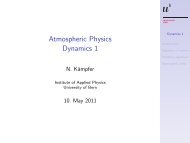
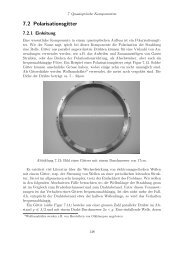
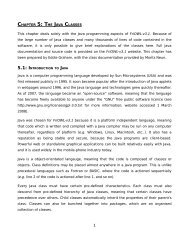
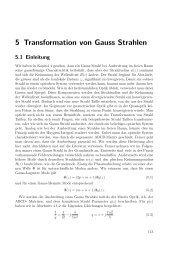
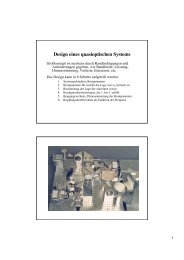
![Kapitel 3: Antennen [4.8 MB]](https://img.yumpu.com/22421230/1/184x260/kapitel-3-antennen-48-mb.jpg?quality=85)
![Kapitel 4: Wellenleiter [4.4 MB]](https://img.yumpu.com/22421225/1/184x260/kapitel-4-wellenleiter-44-mb.jpg?quality=85)
